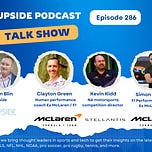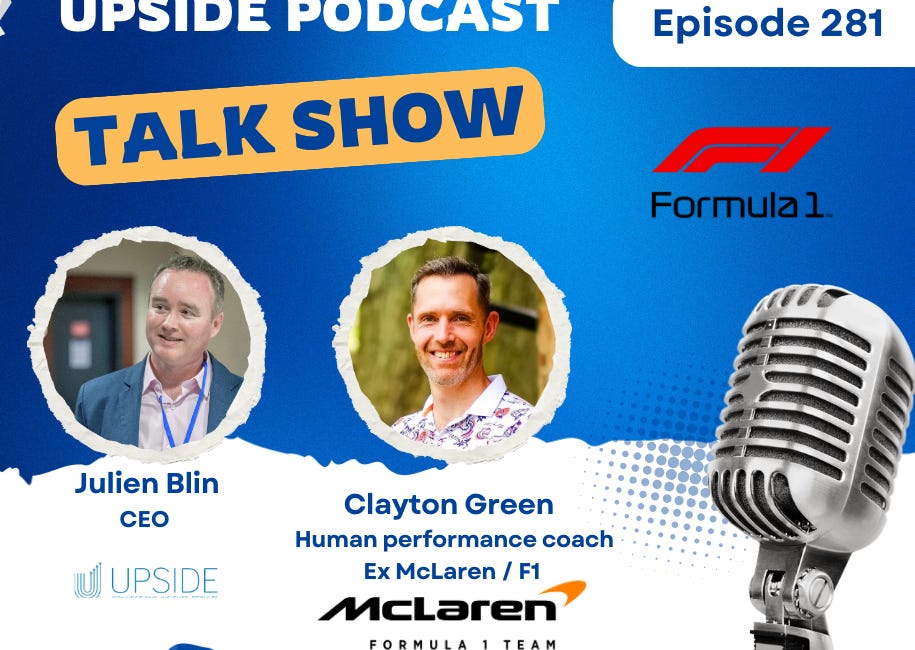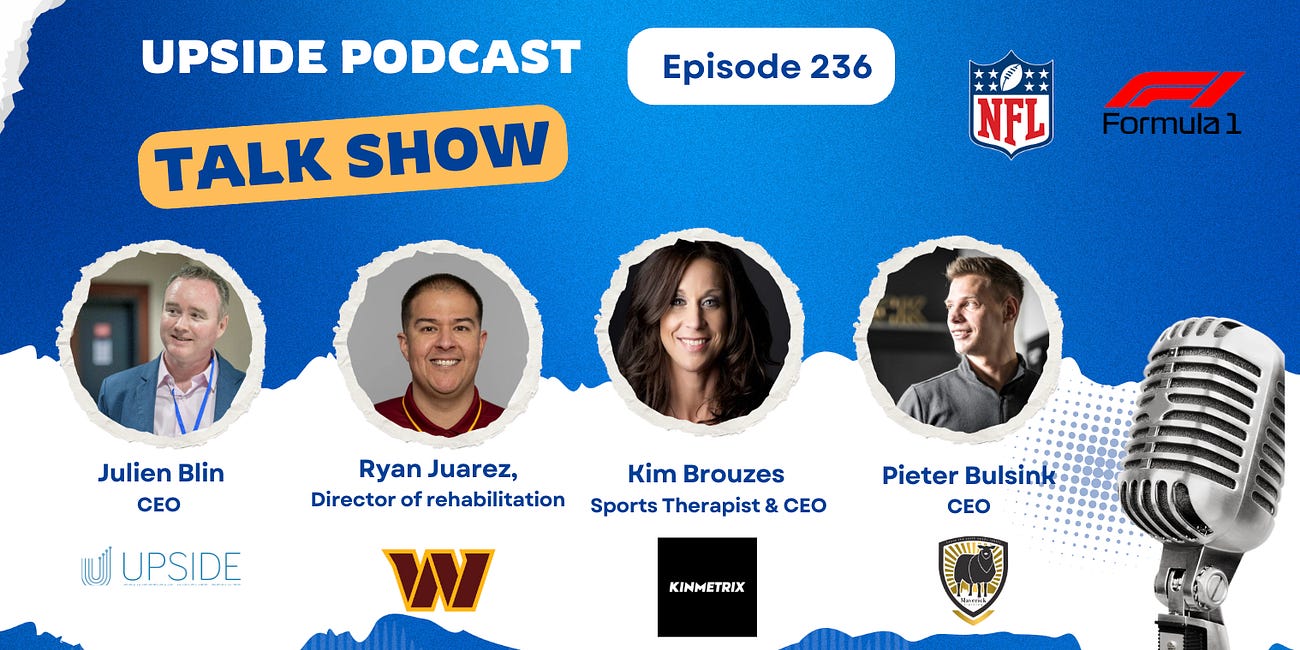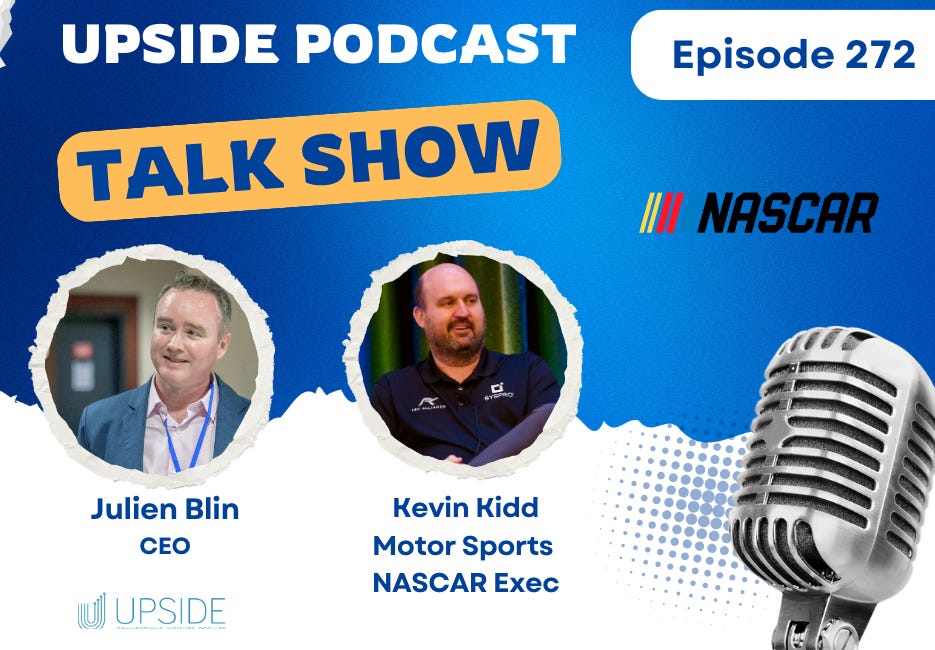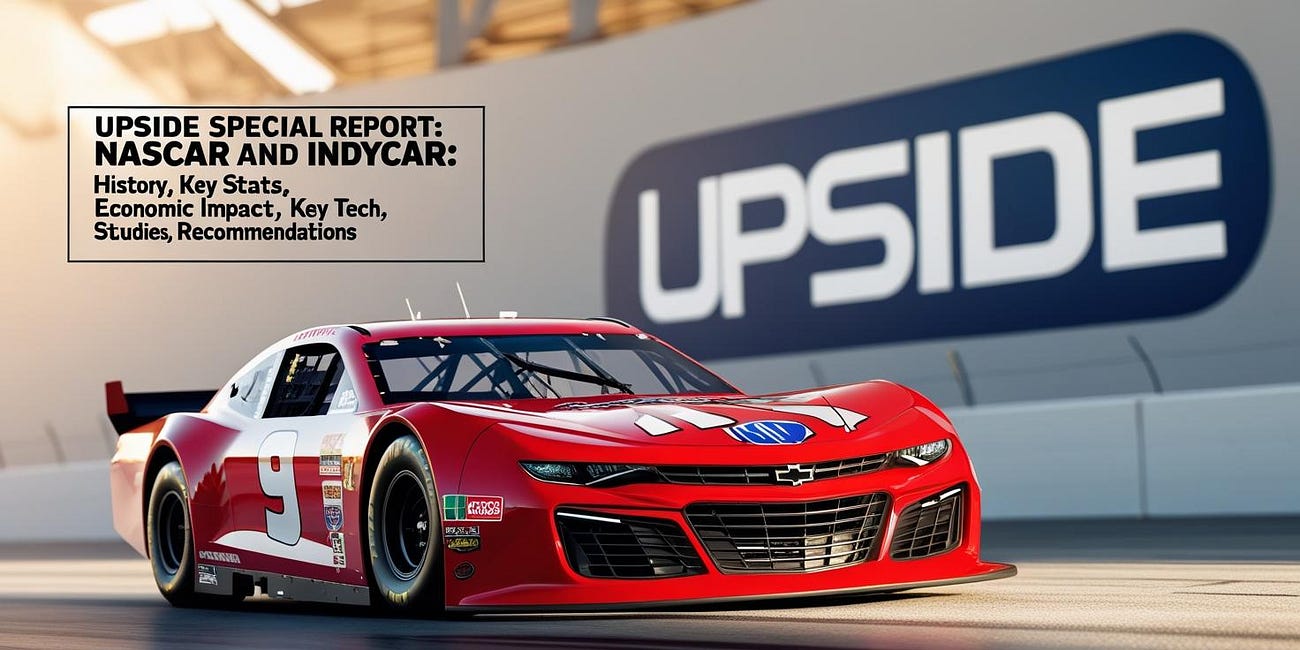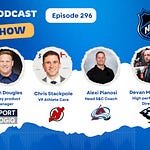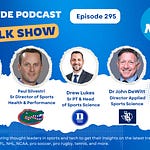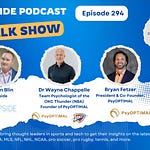This week we have the honor to interview a group of F1/Nascar sports innovation and performance experts.
Clayton Green, an experienced human performance coach that worked in F1. He was at McLaren for 12 years with multiple times F1 champion Lewis Hamilton
Kevin Kidd, a top motor sports executive in NASCAR (Ex RFK Racing). He now works as the North American motorsports competition director for Stellantis.
Simon Reynolds ASCC, an F1 performance trainer He is the director at Formula 1 perform LTD. He previously worked for McLaren for 14 years as the Mclaren driver performance manager. He was also the performance coach of Keikki Kovalainen.
You can watch the video interview below by clicking on the Youtube link. You can also listen to the audio interview by clicking on the link at the top of the page:
📝Show Notes: Through this interview, we touched on the best practices in F1 and NASCAR related to:
Innovation Landscape in F1/NASCAR.
AI and Data Integration.
Human Performance & Training
Future Technologies & Sustainability
Cultural & Structural Differences in Innovation
Psychological & Mental Performance.
You can read the full transcript of the podcast interview located at the top of this blog post.
Here are some of the best quotes of our conversation with Clayton, Kevin and Simon:
1. Innovation Landscape
Simon Reynolds (F1):
“I mean, F1 does have a big tradition, certainly, and a big history, but I don’t think the teams are necessarily kind of restricted by their tradition, if you like. They can be very proud of it and want to present it and obviously play off it if it’s been successful. But in order to be competitive in F1, it is very much about the innovation side. It is about how can you get any kind of edge over your competitors. And normally that’s a technological edge in F1 because they do have a bit more freedom over what they can create in terms of a racing package. So definitely history’s important. Tradition’s important, but I would say innovation is what really drives the teams. The sport probably wants to hold onto the tradition more, but the teams are happy to just go down the innovation route wherever possible.”
Kevin Kidd (NASCAR):
“You know, on the NASCAR side, the story is very similar, surprisingly. I think a lot of folks probably think that Formula One and NASCAR aren’t very similar. But when you lift a hood up, you’ll find that in NASCAR we’re doing a lot of the same activities. Our simulation efforts, our total engineering efforts really are scaled by budget. So we obviously have a little bit less budget to work with than Formula One teams, but the types of activities, the things that we’re doing are very similar... Heritage is something that’s very much part of our sport. It’s something that we all have a lot of respect towards. But quite frankly, it’s good for telling marketing stories. When we really focus on the competition aspect, we try to live at the bleeding edge of technology just the same as the Formula One guys do. Because in the end, you know, Motorsport worldwide is pretty similar. We’re taking inert pieces of metal and carbon fiber, and we’re trying to make them go as fast as possible around a circuit.”
Clayton Green (F1) on rule changes:
“The rules package for the cars changes quite frequently in F1. So we’ve got a big rules change coming up for the 26th season where they’re changing the power units, they’re changing things to do with the aerodynamics as well. And you tend to get shuffling of the pack at that point in time in terms of who’s got the best package. Obviously everyone’s trying to produce the best package that they can, but no one quite knows where any of the other teams are. So you never quite know at the start of a new rules change what’s going on there... It’s like that on a week by week basis. I mean, not so much now as it used to be when Simon and I were at McLaren and in F1 when there was a bit more freedom to spend whatever money you had available on the cars. So every week the cars would be different. There would be little upgrades and stuff coming, and the drivers had to always adapt to a changing performance package underneath them.”
2. AI and Data Integration
Kevin Kidd (NASCAR):
“I think we’re still very early days on this journey. But it is a journey, and if you’re not on board for the journey, then you’re probably going to get left behind in Motorsports pretty quickly. When I look at AI as a topic and how we’re trying to utilize it, we’re trying to make the easy decisions more automated. A typical NASCAR race, and the way NASCAR teams are structured — and boy, we could argue about whether this structure is the right way or not, I have strong opinions on it — but it all kind of funnels up to largely one person who’s making a lot of decisions on behalf of the team during a race. That one person gets overloaded just like that. And if we can use AI to help automate some of those decision making processes and really serve up the right answers at the right time, and have it to be trustworthy and something that the crew chief ultimately believes in and depends on, now all of a sudden we have freed up some cognitive load to allow the crew chief then to focus on the hard decisions that quite frankly, AI might not be capable of handling just quite yet. So if we can just reduce his cognitive load, free up some space to really take on the tough problems, I think personally that’s where we’re at today.”
Kevin Kidd (NASCAR)
“Traditionally in NASCAR there was zero data, like none. It wasn’t until about five or six years ago that that opened up a little bit to the point where each car has a steering sensor, has throttle and brake and GPS. So we have location of the car and speed and engine RPM, things of that nature. It is very simple when compared to Formula One. Formula One, there are 200-300 channels — there’s probably not much that’s not getting measured on a Formula One car. In NASCAR, we keep it very simple by rule, obviously. Us as race teams, we would put as many sensors on the car as we could if we were allowed to. Here’s where it gets interesting though: in Formula One, it’s my understanding that each team has access to their car’s worth of data, and that’s kind of it. In NASCAR, we have access to every car in the field. So not only can we analyze our data, but we can analyze every data point of our competitors as well, which gives us a huge runway for analysis to determine all kinds of things.”
Clayton Green (F1):
“McLaren was, and F1 as a whole was always into big data. It was always about what can we measure and if we could measure something, let’s measure it. We don’t necessarily know what we’re going to do with it right now, but the opinion was always, why wouldn’t you measure something if you could? So you always end up with so much information. There was a danger of paralysis of analysis going on. So they’re always then looking at, well, how can you mine the big data? How can you do predictive analytics on that? And this was before AI was kicking in. So I would imagine now there is a massive push to integrate it as much as possible. Like Kevin said, to try and reduce the cognitive load on the individuals that have got to make strategy decisions. In F1, if it was a really boring race, then the engineers were really happy that they’d done their job really well because it really was about how do we take any kind of chance out of this, how do we control all the variables? How do we predict everything that could happen?”
Simon Reynolds (F1):
“I think the more data points that you are collecting, if you’re collecting hundreds of data points, and I can only speak for Formula One, but then AI is then able to make predictions with future predictions for the following seasons, and that becomes extremely valuable. Compared to NASCAR, Formula One is very much more secretive and closed off to some degree. And I think collecting as many data points as possible, and having AI technology to be able to run that data and look at trends and forecasts and predictions for the future, I think is probably very valuable.”
3. Human Performance & Training
Kevin Kidd (NASCAR on elite drivers):
“I’ve had the good fortune of working with drivers. I’ve worked with the very best, Hall of Fame drivers. And I’ve also worked with very young guys who are just starting their journey, and I’ve worked with the guys in between. And what I can tell you without a doubt within the NASCAR world is that the very best drivers, those Hall of Fame guys — their actual skill behind the wheel to make a car go fast isn’t what separates them. Obviously they’re operating at a high level, the same as everybody else, but that’s not the difference. The difference is how cerebral they are and their ability to think their way through a race. The game is just so much slower for them, so to speak, and they can make good decisions on a more frequent basis. And so that’s what happens during the race. But then the other side of this that I think is an intangible that the very best guys have is their ability to kind of direct and guide the team and make the team stronger with the feedback, with the direction that they give on what they’re feeling in the car. They have that experience, they have that knowledge, and they can point a team in a direction that generally speaking leads to positive outcomes. Race car drivers who can do that and also go fast, those are the ones that win the races.”
Kevin Kidd (NASCAR pit crews):
“In NASCAR, our pit crews — and when I refer to pit crews, I’m talking about the five guys that jump over the wall and change tires and put fuel in the car — they are athletes, hands down. These guys play college football or college baseball. I have not seen many basketball players, but I don’t entirely know why that is, but I have seen a lot of former football and baseball players. And these guys, they were on a path where they were probably pretty successful in college, maybe not successful enough to make a professional career out of it. Or maybe they got to pro football, the NFL and lasted a season or two and then sort of flamed out. These are guys who were in their mid twenties, they’re looking to extend their athletic career doing something. They discover that NASCAR racing is an opportunity to do that, and they, quite frankly, if they keep fit and catch on, they can do this all the way out until 40 or 41 years old... These folks all come in, they’re very much clued in already on what strength and conditioning looks like. Working with human performance coaches they’ve come from programs that have all the coolest things from a data collection standpoint. They’re already in large part, already trained up on how to use the data... If you come to RFK racing now, and you look at the resources, the facilities we’ve put in place to support this part of our program, it would kind of remind you probably of a very small division one school. We’ve got some pretty impressive things that we’ve thrown at the problem. And these athletes, this is all they do, they pit cars for a living. They don’t work on cars. They’re not mechanics or fabricators. They’re not engineers. These guys are all athletes training every day to pit vehicles on a race on Sunday.”
Clayton Green (F1):
“We’ve always kind of alluded to the fact that it was more of a cognitive task that the F1 drivers had to perform, but physical fatigue starts to get in the way of that. So it was about being able to offset the physical element so they could do what they needed to do cognitively... The drivers that could communicate with their engineers and the team better would always do better. Of course the engineers had to set the car up for the driver to get the best out of the driver. I used to always like talking about how things felt, and then the engineers obviously want to deal in numbers and stuff, but the best drivers could find a way of communicating feelings into setup changes and then they’d have a vehicle that did everything that they wanted as well. So it wasn’t just about having the skill, you had to integrate yourself into the team and lead it and develop it as well.”
Clayton Green (F1 pit crews comparison):
“I think the biggest difference that I can see between F1 and NASCAR would certainly come round to the pit crew. I know that in NASCAR, you have the designated pit crew of people who are ex-athletes. And it is a very physically demanding role that they undertake. With the pit crew in F1 we have three people on each corner changing a tire. So you’ve got 12 people around the car. You’ve got front rear jacks, you’ve got about 14 people or so to change four tires, which is why we can do a bit quicker than NASCAR. But those individuals then, although they’re trained much more athletically now than they ever were, they aren’t athletes. They are the mechanics that work in the garage on setting up the car, and that is their first and most important role. Then from that pool of mechanics, because we couldn’t take extra people to race to just do the pit stops for us, you’d pick the best people, get them into the right positions. There was a lot of sports analysis done on kind of what body shape, what kind of strength do people need for certain things, vision track, all sorts of things that you bring in from a normal kind of athletic domain. They weren’t athletes in the first place. So a lot of the training was then also about keeping them healthy over the course of the season.”
Simon Reynolds (F1 on pit crews as athletes):
“When it comes to the roles within Motorsport, the pit crew’s role, or the race team’s role is the preparation of the car and to have a positive effect during the race to manage the changes of tires obviously in as quicker time as possible. And to react as quick as possible to changes that are occurring in the race with weather conditions and things like that... When we come to human performance, we are now treating the pit crews as athletes. And I think Clayton and myself and the medical team and the chief medical officer, Dr. Aki Hintsa at the time were really innovating that in the early days of 2007, 2008, 2009 of training the pit crews as athletes. And from that point forward, obviously the teams then started to do the same. And seeing that pit stop times were coming down as a consequence, and now we’re talking about seconds as opposed to multiple seconds in the earlier days when the pit crews weren’t necessarily treated as athletes.”
4. Cultural & Structural Differences in Innovation
Kevin Kidd (NASCAR):
“From our side, we are absolutely a fan engagement sport. We’re nothing without our fans. We’re nothing without the television broadcast. We very much cater to our fans and that’s what’s most important. I think maybe culturally, what’s a little different than Formula One is that our fan base really resonates with the stories of the drivers and the threads that kind of get pulled in and out with the drivers. And quite frankly, in the American Market we’re a little bit — I don’t know if we’re unique or not — but fans enjoy drama. So the stories that can add drama to the sport, those are the things that really sort of engage. Whereas I think, and again, maybe being a little presumptuous here, but on the Formula One side, fans really resonate in some part to the technology story. Technology is deeply rooted in both sides in Formula One and NASCAR. We just tend not to tell that story quite as often and really lean hard into the drivers and what’s going on and the dramatic parts of the sport.. who’s fighting who and why are they fighting? And what kind of drama we’re gonna see on the racetrack come Sunday.”
Simon Reynolds (F1):
“I think fan engagement is important in F1, and I think it’s a growing part of F1 now. I think F1 kind of found itself in quite a privileged position, if you like, with the global backdrop that it managed to establish. And it does have a huge following, but this is my own opinion as opposed to all the fans that are out there — but I’m never convinced that all the fans really know the intricacies of F1 and appreciate that the drivers don’t all have a level playing field they compete on. Because you do talk to a lot of people who always thought, well, why is so and so doing so badly this year? And you’re like, well, they’re not, but the team, the car is not where it was. So I think there is a big opportunity for the fan engagement side to develop in F1, although I think the teams do a lot of fan engagement themselves rather than F1 as a marketplace... I think the fan engagement is crucial. Drive to Survive was a huge influence on fan engagement and I think the documentaries that Netflix and other companies that were produced on motor sport have had huge engagement from the younger population. I also think McLaren have done an incredible job at fan engagement together with other teams. But I think with having Lando and Oscar who are very charismatic and young, both exceptionally talented and great with the fans, I think they have really enhanced the fan engagement to such a high degree.”
You may also like:
🎙️ 🏎️ Upside Video Chat with Clayton Green, Experienced Human Performance Coach (Ex McLaren / F1)
Today we have the honor of interviewing Clayton Green an experience human performance coach that worked in F1. He was at McLaren for 12 years with multiple times F1 champion Lewis Hamilton.
🎙️ Upside Chat with Pieter Bulsink, CEO, Maverick Training, a Leading Sports Performance Company in F1 and Other Sports.
Today we have the honor of interviewing Pieter Bulsink, CEO of Maverick Training, a sports performance company focused on elite athletes in F1 and other sports.
🔥Upside NFL/F1 Group Chat with Pieter Bulsink (Maverick Training/F1), Kim Brouzes (Kinmetrix), Ryan Juarez (Commanders/NFL) On Neck Training
This week we have the honor to interview a group of rehab and performance experts across the NFL and F1. We discussed neck training, their approach to neck training, the various modalities, best practices and trends that they are seeing in the market.
🎙️ Upside Video Chat with Kevin Kidd A Top Motor Sports Executive in NASCAR.
Today we have the honor of interviewing Kevin Kidd a top motor sports executive in NASCAR.
🏁 Upside Special Report: NASCAR and IndyCar: History, Key Stats, Studies, Tech, Recommendations to Startups
As the 2025 seasons of NASCAR and IndyCar come to a close, motorsports fans are once again captivated by the high-speed drama, strategic brilliance, and engineering marvels that make each series unique. Though both are top-tier American motorsports leagues, they operate in largely different ecosystems—with divergent cultures, technologies, and fan bases…

